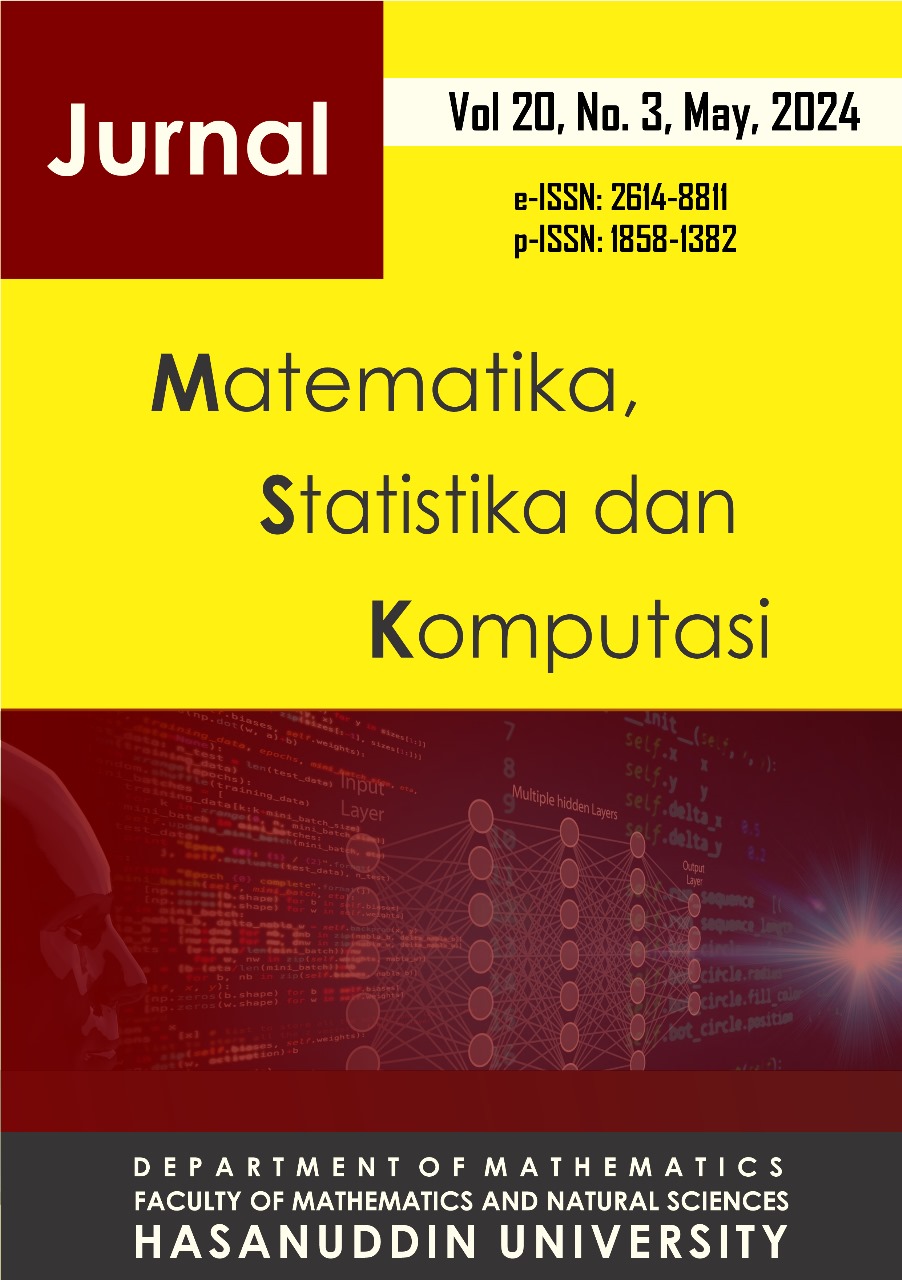Spatial Weighting Selection in GSTAR and S-GSTAR Models for Temperature Prediction
DOI:
https://doi.org/10.20956/j.v20i3.34305Keywords:
Space-time, GSTAR, seasonal, temperature,, predictionAbstract
Recent research in time series analysis indicates that events at a particular location are not only influenced by events at previous times but also by proximity between locations. Events influenced by both space and time can be modeled using a space-time model. GSTAR model is one such space-time model. In its development, time series data exhibiting seasonal patterns are modeled using Seasonal GSTAR (S-GSTAR). The GSTAR and S-GSTAR models are used to model temperature in the Banjar, Cilacap, and Sleman Districts. The purpose of employing both methods is to compare the best model for modeling temperature at these three locations. Spatial weights used include inverse distance weighting using the Euclidean distance formula, uniform weighting, and cross-correlation normalization weighting. Ordinary Least Squares (OLS) is the estimation method used in this study. The best model obtained is S-GSTAR with inverse distance weighting, as this model has the smallest RMSE value.Downloads
References
. Anselin, L., 1988. Spatial Econometrics: Methods and Models. Kluwer Academic Publishers, Dordrecht.
. Ardianto, M., 2014. Pemodelan Generalized Space Time Autoregressive (GSTAR) pada Tiga Periode Waktu (Studi Kasus Inflasi di Lima Kota Besar di Pulau Jawa). Jurnal Mahasiswa Statistik, Vol. 2, No. 4, 265-268.
. Borovkova, S., Lopuhaä, H. P., & Ruchjana, B. N., 2008. Consistency and Asymptotic Normality of Least Squares Estimators in Generalized STAR Models. Statistica Neerlandica, Vol. 62, No. 4, 482-508.
. Dey, B., Roy, B., Datta, S., & Ustun, T. S., 2023. Forecasting Ethanol Demand in India to Meet Future Blending Targets: A Comparison Of ARIMA And Various Regression Models. Energy Reports, Vol. 9, 411-418.
. Gusnadi, R., Rahmawati, R., & Prahutama, A., 2015. Pemodelan Generalized Space Time Autoregressive (GSTAR) Seasonal pada Data Jumlah Wisatawan Mancanegara Empat Kabupaten/Kota di Jawa Tengah. Jurnal Gaussian, Vol 4, No. 4, 1017-1026.
. Hadi, A. F., Yudistira, I., Anggraeni, D., & Hasan, M., 2018. The Geographical Clustering of The Rainfall Stations on Seasonal GSTAR Modeling for Rainfall Forecasting. In Journal of Physics: Conference Series, Vol. 1028, No. 1, 012238.
. Huda, N.M., Imro’ah, N., 2023. Determination of The Best Weight Matrix for The Generalized Space Time Autoregressive (GSTAR) Model in The Covid-19 Case on Java Island, Indonesia. Spatial Statistics, Vol. 54, 100734.
.Mukhaiyar, U., Huda, N.M., Sari, R. K. N., & Pasaribu, U. S., 2019. Modeling Dengue Fever Cases by Using GSTAR (1; 1) Model with Outlier Factor. In Journal of Physics: Conference Series, Vol. 1366, No. 1, 012122.
. Mukhaiyar, U., Bilad, B. I., & Pasaribu, U. S., 2021. The Generalized STAR Modelling with Minimum Spanning Tree Approach of Weight Matrix for COVID-19 Case in Java Island. In Journal of Physics: Conference Series, Vol. 2084, No. 1, 012003.
. Mukhaiyar, U., Nabilah, F. T., Pasaribu, U. S., & Huda, N. M., 2022. The Space-Time Autoregressive Modelling with Time Correlated Errors for The Number of Vehicles in Purbaleunyi Toll Gates. In Journal of Physics: Conference Series, Vol. 2243, No. 1, 012068.
. Suhartono, S., Prastyo, D. D., Kuswanto, H., & Lee, M. H., 2018. Comparison between VAR, GSTAR, FFNN-VAR and FFNN-GSTAR Models for Forecasting Oil Production. MATEMATIKA: Malaysian Journal of Industrial and Applied Mathematics, Vol. 34, No. 1, 103-111.
. Utami, R., Nurhayati, N., & Maryani, S., 2021. Forecasting The Amount of Rainfall in West Kalimantan Using Generalized Space-Time Autoregressive Model. In IOP Conference Series: Earth and Environmental Science, Vol. 746, No. 1, 012035.
. Wei, W.W.S., 2006. Time series Analysis Univariate and Multivariate Methods. Addison Wesley Publishing Company, Canada.
. Zewdie, M. A., Wubit, G. G., & Ayele, A. W. 2018. G-STAR Model for Forecasting Space-Time Variation of Temperature in Northern Ethiopia. Turkish Journal of Forecasting, Vol. 2, No 1, 9-19.
Downloads
Published
How to Cite
Issue
Section
License
Copyright (c) 2024 Author and publisher

This work is licensed under a Creative Commons Attribution 4.0 International License.

This work is licensed under a Creative Commons Attribution 4.0 International License.
Jurnal Matematika, Statistika dan Komputasi is an Open Access journal, all articles are distributed under the terms of the Creative Commons Attribution License, allowing third parties to copy and redistribute the material in any medium or format, transform, and build upon the material, provided the original work is properly cited and states its license. This license allows authors and readers to use all articles, data sets, graphics and appendices in data mining applications, search engines, web sites, blogs and other platforms by providing appropriate reference.








